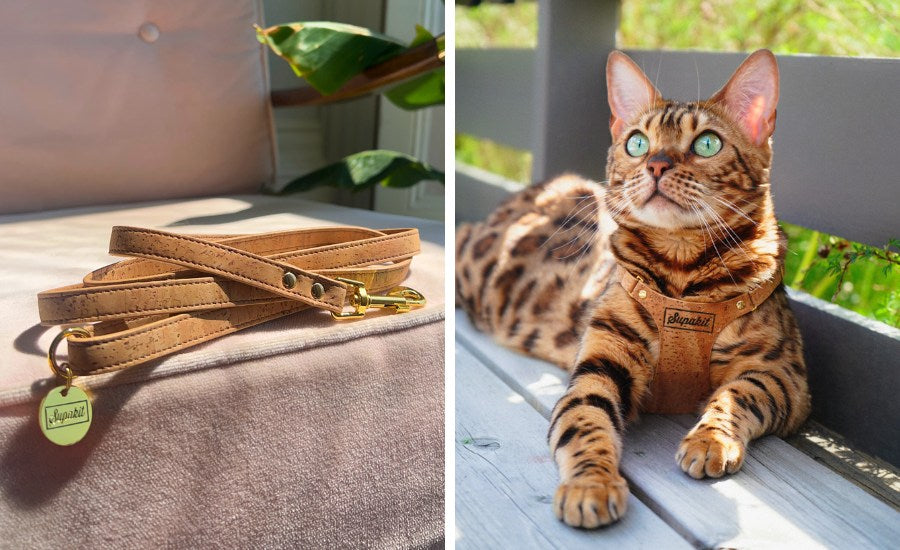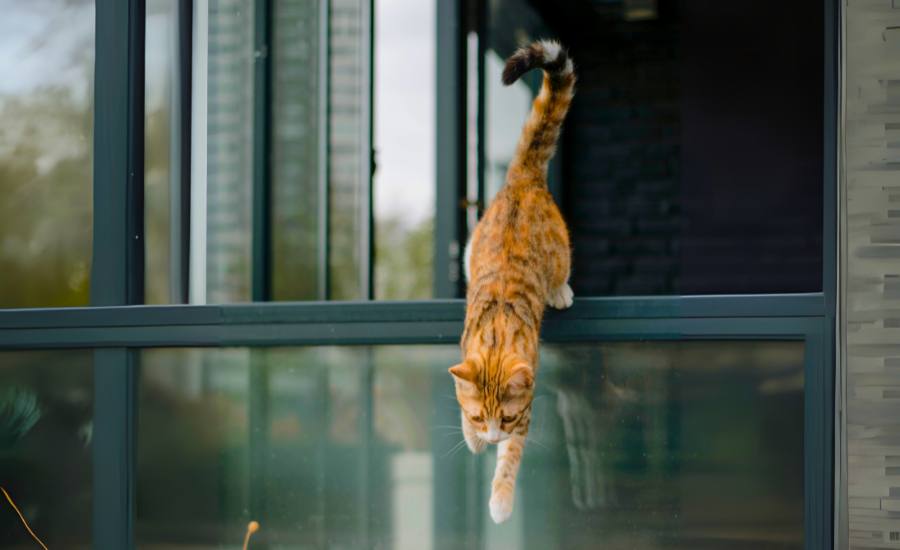Cat Exploring for Beginners - With Hasara Lay from Catexplorer
Supakit co-founders, Leili and Kevin were lucky enough to sit down with podcast host and cat exploring expert, Hasara Lay from Catexplorer Community to discuss advice for beginner cat explorers on our Instagram Live #catchat. Read the chat below or check out the full interview on our IGTV channel here.
 Instagram @catexplorer.community
Instagram @catexplorer.community
Leili: We're honoured to have you join us today, Hasara. Could you tell those who aren't familiar with waht you do what Catexplorer Community is all about?
Hasara: Of course, a Cat Explorer is both a human and a feline that go exploring together and the Catexplorer Community is an online group of people that connect because we explore with our cats. When I first started exploring with my cat, I thought I was the only one in the world who did this by myself, it was only when we joined social media and started connecting with other cat owners that I realised there were other people like me! I got so much help from everyone and I just wanted to give that opportunity to everyone else.
Leili: What are the potential benefits of cat exploring?
Hasara: I think a lot of humans can relate to this now as most of us have been through lockdown. But for indoor cats, they’re within these tiny four walls and they don’t get to go outside. They don’t get to feel the wind in their whiskers or the grass on their paws and as we’ve all learned, being inside over the last couple of months is that it can be quite boring and it can be the same for our cats.
Taking them outside is another form of enrichment, it lets them feel the grass and sniff those smells they love. I also find that our cats sleep so much better when they’ve been cat exploring!
Related post: 'How To Harness Train Your Cat'
Leili: Where do you think a person’s cat exploring journey could begin? What should they do first?
Hasara: The first place to start is inside your home. A lot of us get very excited to go outside and take them on a hike as soon as possible. That can be a bit of a shock to our cats, the first thing they need to do is get used to the harness at home. It does depend on your cat, for people that have kittens it might take you a while to understand what drives them. For example, I have a cat that is very food motivated and one that is play motivated so we had to take two different approaches to get them used to their harnesses. For the cat that is food motivated we used treats to slowly get him used to wearing the harness inside the house. The other one we used play and used her favourite toy.
I recommend that everyone start this at home, there are less noises and things that might scare your cat. It’s also a safe environment for them. After that, I recommend slowly expanding those boundaries. Slowly introduce new noises, smells, people, animals etc. The first place I recommend you go with your cat on a harness is your balcony, backyard or courtyard. Somewhere very small where you can control who is in there and what might spook them.
Then slowly expand those boundaries, go somewhere that has a few people. For example, if you live in an apartment building and allowed to, go into your communal corridor and then look for somewhere that is close by, maybe a laneway or a small park. It doesn’t have to be a big, beautiful park, for cats sometimes those little gardens in front of apartment buildings are great just to get them used to being out and about. It’s also a place where there are less likely to be lots of people. Then slowly start going to places that are a little bit busier.
I’d also recommend getting started with a ‘safe space’ like a cat backpack or stroller. This is great because when we’re out, we can’t control the people out there or dogs that are around so a safe space is a great place for your cat to jump into if they’re feeling a little bit scared.

Instagram @catexplorer.community
Kevin: It’s interesting you suggest to explore in a small space because as humans, we tend to think of exploring as to the horizon and beyond but I suppose you have to see it from your cat’s perspective that the new place they’ve never seen is literally round the corner from your back garden. It doesn’t always have to be a great, big adventure.
Hasara: During this coronavirus lockdown period, it’s been a big eye opener for us because we realise that our cats’ favourite places is a really boring laneway behind our apartment block. They have their favourite bushes, they’ll go to the same bush and check that out and it’s one of their favourite places to go!
Leili: How do you get your cats used to wearing a harness?
Hasara: Try and understand what motivates your cat. If your cat is food motivated use their favourite treats as a reward for trying out the harness. I’m speaking from experience because our food motivated cat is so much easier to train than the one that isn’t. Our other cat isn't motivated by traditional treats but we've found some others, like cooked chicken than will motivate her.
The analogy I like to use is – imagine we never wore clothes and then suddenly someone puts something on us it would feel like a straight jacket. We would do the ‘flop’ that our cats do when they first put on their harness. So our aim is to try an encourage our cats to realise that wearing a harness is a normal thing.
When you first show your cat the harness, let them sniff it and give them treats so they start seeing it as a good thing. Put it near them, lay it on top of them without clasping it and each time treat them, then slowly you can move on to clasping the buckles etc. Remind yourself to treat them throughout the whole process! Try not to rush to the next step, it might take a couple of weeks until they’re comfortably wearing the harness.
Hasara: Try and introduce the leash at home or in that safe outdoor environment you’ve found. They’re more likely to walk outside than if they’re at home. Just let them walk around that safe space and get used to having a leash attached to the harness. You can treat your cat throughout this process too.
Related link: How To Harness Train Your Cat Course
Leili: As a nervous cat mum myself, I know that introducing new things when you’re in a safe environment brings your anxiety levels down, which is also important for your cat. Would you agree?
Hasara: That’s something that I’ve learned over the past couple of years that it is so important how we are reacting to things. Our cats feed off our energy, so if you’re stressed they’re going to feel the same thing. It’s also a great opportunity for you to start giving them that sense of calm, as long as you’re calm your cat is going to stay calm too.
Leili: A big concern for people is that their cat’s harness is safe and secure. What can people do to make sure their cat is safe in their harness before they venture out?
Hasara: Always make sure the harness is on properly, I know Supakit have a guide where you make sure you can fit one finger between the cat’s body and the harness all the way around. A personal recommendation is that if you haven’t been exploring with your cat for a while, make sure their harness still fits properly, your cat may have lost or put on weight since your last trip and may need their harness adjusting.
I recommend that ‘safe space’ again. If your cat does manage to get out of their harness and they feel stressed and they know that their backpack or stroller is their safe space, they’re more likely to jump in there. You can also take a pillow case with you as they’re great if you need to grab your cat.

Leili: If we’re picking up signals from our cat that they’re not totally relaxed in this outdoor environment, what should people do next if their cat is anxious when they head out?
Hasara: It depends on the level of anxiety. It’s quite normal to feel some degree of anxiety when you're going somewhere new. It’s great that people are picking up on these signals because it means they’re watching their cat and that’s the main thing you need to be doing. I recommend taking a step back if their anxiety concerns you. For example, if you started in your courtyard and have moved to a park, go back to your courtyard so your cat is comfortable again. Then find an in between spot, head to a quiet park rather than a busy one.
‘Trigger stacking’ also helps, the best way to describe this is to imagine that one day you woke up late, you didn’t have time to make coffee, you rushed to work running late, traffic was bad etc. Usually you could handle all these things separately, but put them all together and you become a bit of a mess! This is the same from a cat’s perspective; you may have put them in their backpack but they were napping and didn’t really want to go, then the car was too hot or too cold and then you reach the park. By this point the trigger stacking has already gone quite far so by the time they get to the park they’re probably pretty cranky – then they see a dog and that might push them over the edge. So think about your cat’s day and work out if their behaviour is because of trigger stacking or is there something else that is making them feel uncomfortable.
Leili: Would you recommend going home if you think a trigger stacking scenario has happened or could you just introduce a ‘time out’?
Hasara: It depends on your cat. Personally, we do ‘time out’ for our cats in the back of the car or backpack if we can’t go home straight away. But sometimes the easiest option is to go back home.
Leili: We’ve had a a question regarding vocalisations while out exploring, what are your experiences of this?
Hasara: We’ve definitely had experience with this! Sometimes cats will make noises while out exploring that they don’t make at home so you do have to learn what these mean while you’re out exploring. Our cat, Noxie can walk really far and she will be meowing the whole time, telling us about the different things that she’s seeing. Or she’ll meow and then sprint so we have to be ready to sprint with her! Equally, she can get very cranky when it’s time to come home and her vocalisation then might sound quite bad to people around us! As an introvert, I found that quite stressful, I didn’t like people thinking I was torturing my cat! So we’ve now developed a routine when we get home, she get lots of treats and a cuddle to make coming home more bearable.
Leili: Another question we get a lot is how do you handle people’s interest when you’re out with your cats?
Hasara: I’ve found having answers already formulated in my head very helpful. I often get the question “does your cat really like that?” so my preprepared answer is always “Yes, they really do” with an example of when we’ve gone out and they’ve enjoyed themselves so much. Often it’s questions about the harness or backpack so I’ll have some tips prepared on how to harness train cats and give them resources to check out such as our Facebook group or podcast.
Leili: What are your thoughts on the best age to start harness training your cat?
Hasara: Age is just a number, you can start at any time. For young cats it’s important for them to be fully vaccinated before venturing out. I’d recommend checking in with your vet before starting to explore, for example there can be different types of ticks in each region that could affect your cat so it’s important to get this sort of information from your vet before heading out.
Leili: How do you manage if you run into a dog that isn’t a fan of cats when you’re exploring?
Hasara: If the dog’s owners are there, it makes it a lot easier to communicate your cat’s fears. I usually say “my cat is not ok, I need your help, could you please leash your dog?” rather than coming across confrontational and accusing their dog of attacking your cat. Again, I really recommend getting those safe spaces for your cat to retreat into. It’s also important not to panic and keep calm for your cat.
Related post: 'Cat Walking, Your Questions Answered!'







